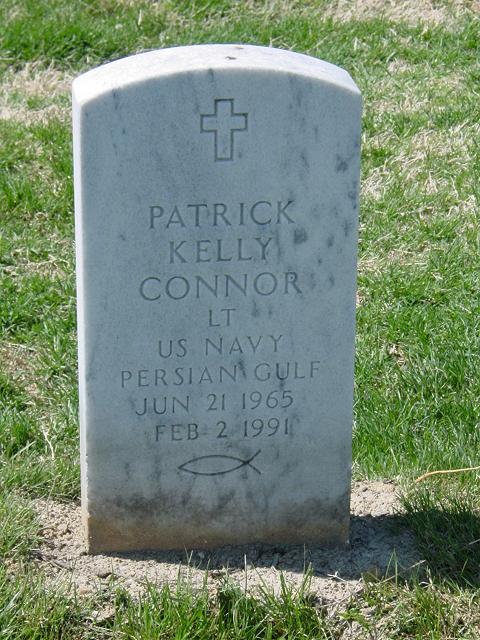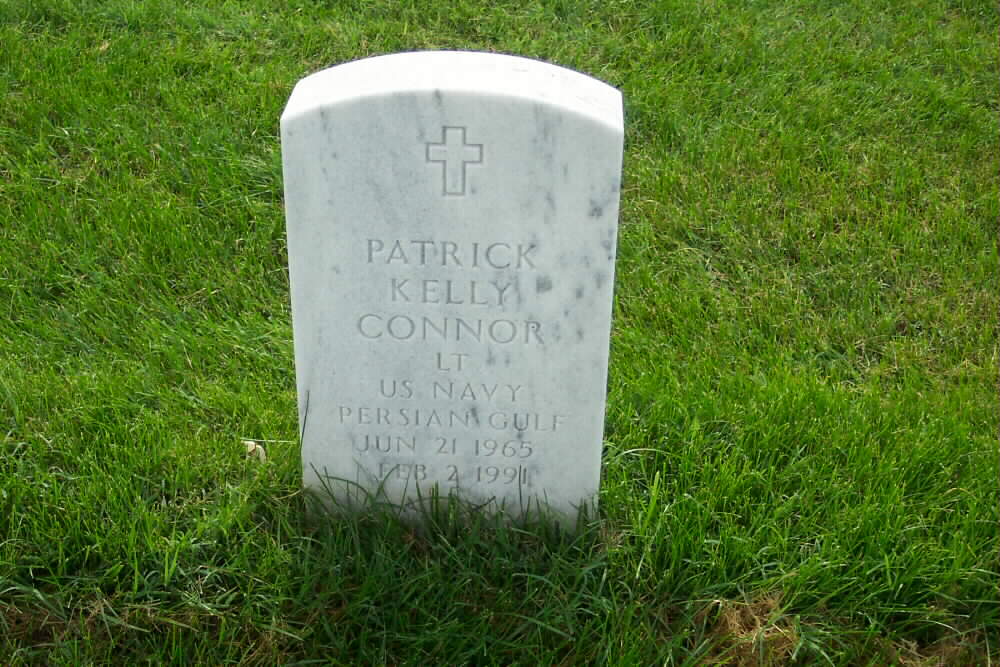The Grumman A6 Intruder is a two-man, all weather, low-altitude, carrier based attack plane, with versions adapted as aerial tanker and electronic warfare platform. The A6A primarily flies close air support, all weather and night attacks on enemy troop concentrations, and night interdiction missions. Its advanced navigation and attack system allows small precision targets, such as bridges, barracks and fuel depots to be
located and attacked in all weather conditions, day or night. Their crews are among the most talented and most courageous to serve the United States.
Lieutenant Commander Barry T. Cooke and Lieutenant (jg) Patrick Connor are Intruder pilots assigned to Attack Squadron 36 (the “Roadrunners”) onboard the USS ROOSEVELT in the Persian Gulf. The Squadron’s home base is at Oceana Naval Station, Norfolk, Virginia.
On February 2, 1991, the Intruder on which Cooke was the pilot and Connor the co-pilot, was shot down off the coast of Kuwait during a strike mission against Iraqi warships. Cooke and Connor were declared Missing in Action.
Search and rescue efforts were conducted for five days and then suspended, without having found the missing airmen. Aircraft wreckage was located in the water off Kuwait City, and according to one Connor family friend, the Navy changed the status of the airmen to lost at sea. However, Pentagon spokesmen, as of February 7, still list the two as Missing in Action. Connor’s family, who has been intervied by various media, has hope that the two were able to eject safely and survive or be captured.
Barry T. Cooke was a native of Austin, Texas and was a 1973 graduate of Austin McCallum High School. He was married, and he and wife, Letitia, and their three children lived in Virginia.
On 2 February 1991, VA-36 suffered the combat loss of an A-6E intruder, shot down off Faylaka Island, and its crew, Lieutenant Patrick K. Conner and Leiutenant Commander Barry T. Cooke. The other was an F/A-18 and its pilot, lost at sea while returning from an overland strike mission. They flew from the deck of the USS Theodore Roosevelt (CVN-71).
News Report:
The remains of a United States Navy Aviator reported shot down in a bombing mission over Iraq have been recovered in the Persian Gulf, Navy officials said. Connor, 25, bombadier-navigator on an A-6 Intruder, was found on March 31, 1991. He was attached to Attack Squadron 36 at Oceans Naval Air Station at Virginia Beach, Virginia. The unit was flying from the carrier USS Theodore Roosevelt. His remains were taken to the military’s mortuary at Dover Air Force Base in Delaware and positively identified as his. The pilot of the aircraft, Lieutenant Commander Barry T. Cooke, 35, was still listed as missing in action. The plane was shot down on February 2, 1991. Connor was originally from Columbia, Missouri, and was a Navy Reserve Officer Training Corps (ROTC) candidate at the University of North Carolina. He had served on active duty for three years. (June 21, 1965-February 2, 1991).
He is buried in Section 60, Grave 7717, of Arlington National Cemetery.
Friday, April 12, 1991
MISSOURI NATIVE, KILLED IN GULF WAR, IS BURIED
Lieutenant Patrick Kelly Connor, a Missouri native and Navy flier killed in the Persian Gulf War, was buried Thursday with full military honors at Arlington National Cemetery.
”We gather to not only say goodbye . . . . We’ve come for some other special reasons as well. We’ve come to give thanks to almighty God for giving us the gift of Patrick’s life,” said Lieutenant Peggy Beulow, a Navy chaplain.
Connor’s flag-draped casket was brought to the cemetery on a horse-drawn caisson. The flag for the casket was given to his mother. Flags also were given to Connor’s two brothers and his fiancee.
The Purple Heart and National Defense Service Medal were presented to his parents.
Connor, 25, of Virginia Beach, Virginia, was a navigator-bombardier on a carrier-based A-6E Intruder attack bomber that was lost on a combat mission off the coast of Kuwait on February 2. He was initially reported as missing in action, but his remains were recovered. The pilot is still listed as missing in action.
Connor was born in Columbia and graduated from Hickman High School, where he was a varsity soccer player and an honors student.
He attended the University of North Carolina at Chapel Hill on a Navy ROTC scholarship and received an officer’s commission in 1987.
He was assigned to an attack squadron aboard the carrier USS Roosevelt at the time of his death.
Among the survivors are Connor’s parents, William and Marsha Connor of Marcellus, N.Y.; two brothers, Navy Lt. Jeffrey W. Connor of Pensacola, Fla., and Scott H. Connor of Glenside, Pa.; and grandparents, Robert Kervyn and Caroline Kelly of Carthage, Mo.; a step-grandmother, Sophie Connor of Webster Groves, Mo.; and fiance, Stephanie Schupe of Virginia Beach.
December 17, 1995
On a cool day in February 1991, a rude interruption changed my life.
At age 25,1 had just returned home to my Stewart Road bachelor pad to find in the newspaper my lifelong friend Pat Connor’s picture on the front page. The big headline read, “Connor MIA “
On Easter Sunday of that year, the Navy recovered the body of Lt. Patrick Kelly Connor from me waters of the Persian Gulf and announced plans to bury him at Arlington National Cemetery in Washington, D.C.
I had not seen or spoken to Pat since 1983, but I always thought our paths would cross eventually and we would make up for all the intervening years.
In utter disbelief, I took time off from my university job and drove to Washington for the funeral. I left Columbia at 8 p.m. and arrived at Arlington National Cemetery 14 non-stop hours later to stand graveside. I had sped 70-plus mph to a place where I did not want to be, in a little red sports car, the thing with which most young men are supposed to be concerned.
“Do not pass go. Do not collect $200. Go directly to the hill on the other side of the Potomac River and watch the burial of a friend from Hickman High School.”
I stood and watched the funeral, the family, the Navy brass, congressmen and military bands. Forty five minutes later, it was over. The limousines rolled out, the bands and press were gone. I was alone, in a black suit, with the “backhoe” committee and 300,000-plus white headstones in a sea of emptiness. I had just arrived, and I was not ready for it–or Pat Connor–to be over.
Six months later, I was still emotional about it. I couldn’t believe that Pat — a smart, kind, friendly, typical Midwesterner, born and raised in Columbia (Missouri) –had left this earth when it was his sandbox. He was only 25.
He was in the college ROTC and then on active duty in the Navy as a navigator of an A-6 Intruder. Slowly, as I talked with Pat’s parents and read papers and articles he had written in college and in the Navy, I came to a broader understanding of why.
He did not die for oil, the president, a political party, or because of a faulty career decision. Pat made a conscious choice to use his abilities, talents and level-headed temperament to serve his country and help control the most deadly weapons on earth so that I–we-did not have to. I had been the “Joe Consumer” who did little to protect freedom other than to vote occasionally. Pat had chosen to put his life in danger because he believed that it was the right thing to do.
It then became my goal to build a memorial and to have it placed at the Boone County Courthouse. If not me, who? Working with the Memorial Day Weekend Salute to Veterans organization, we raised $3,500. The memorial was carved and dedicated in May 1992 to Lt. Patrick Kelly Connor and Army Spc. Steven Farnen.
This year, I discovered Pat’s legacy lives on. Once again, I found myself racing across the country to Patriots Point in Charleston, S.C., to see an A-6 Intruder placed on permanent display on the deck of the aircraft carrier USS Yorktown. This plane is dedicated to all pilots who gave the ultimate sacrifice for their country, but Pat’s name is stamped forever on its side. It’s painted to match me one that was destroyed by enemy fire that February day in the Persian Gulf.
Other patriots were present that day: Medal of Honor recipient Vice Adm. James Stockdale and Rear Adm. and former U.S. Sen. Jeremiah Denton. They were honored for their sacrifice as prisoners of war in Vietnam for more than seven years. They spoke the same words that Col. Fred Cherry says every Memorial Day in Columbia: “Freedom isn’t free.”
Pat knew what he was doing and why he did it. He knew that he was in Author Peter Scavone on the deck of the aircraft carrier USS Yorktown In Charleston, S.C., with an A-6 Intruder on permanent display that Is stamped with the name of his lifelong Irlend Pat Connor of Columbia.
In World War 11, German and Japan were not beaten by the allies, they were liberated from tyranny and given the freedom that comes with democracy. Korea, Vietnam, the Persian Gulf and most likely Bosnia are attempts to liberate and democratize societies that know oppression firsthand. That is what compelled Connor to go to Kuwait twice. Once in November 1990 under Operation Desert Shield and again in January 1991 in Operation Desert Storm.
A wise man who lives in Columbia spoke words that Pat would understand: “The person who said ‘War is hell’ was telling the truth, but the cost of not protecting freedom, is far, far greater.”
Former President Richard Nixon wrote, “A democracy has never, and will never start a war.” Pat gave up his life to be part of the solution. I sure do miss him.
“To the men who gave their lives, and the men and women who offered but, were spared.” –Desert Storm Memorial Boone County Courthouse.
Peter Scavone is a former Columbia resident who worked to have a veterans memorial placed at the Boone County Courthouse.
Michael Robert Patterson was born in Arlington and is the son of a former officer of the US Army. So it was no wonder that sooner or later his interests drew him to American history and especially to American military history. Many of his articles can be found on renowned portals like the New York Times, Washingtonpost or Wikipedia.
Reviewed by: Michael Howard


